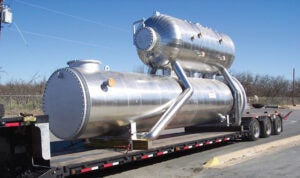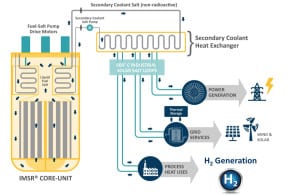industrial
-
O&M
Boilers 101: What They Are and How They Work
Boilers are all around us. From home water heating to massive industrial applications, they are everywhere. This article covers boiler basics, including the basic types of packaged boilers and their thermal configurations.
-
Trends
Buildings Will Devour 50% of New Global Electricity by 2035—Here’s How Smart Design Can Change That
Nations around the world are undergoing a seismic shift, switching from fossil fuels to renewable energy to meet net-zero targets. But one sector is set to dominate new demand—buildings.
-
Commentary
Funding the Power Surge: Navigating the Trillion-Dollar Investment in the U.S. Power Sector
The U.S. power sector stands at a juncture, facing a confluence of factors that are poised to trigger an era of unprecedented growth and necessitate a large influx of capital. Driven by the increasing demand from data centers, the reshoring of manufacturing, and electrification across transportation, heating, and industry, the demand for electricity is rising at a pace unseen in recent decades.
-
Solar
Shedding Light on Solar Incentives—Why Property Owners Remain in the Dark
As the world grapples with climate change and seeks sustainable energy solutions, solar energy has emerged as a front-runner in renewable energy sources. Despite the numerous benefits associated with solar power, many property owners remain unaware of the federal, state and utility incentives available to them for installing solar panels. There are also many grant […]
-
Solar
Arcadia, Perch Energy Announce Major Community Solar Deal
A Massachusetts-based solar energy firm is merging with the community solar arm of a renewable energy group to create one of the country’s largest pure-play community solar companies. Perch Energy, based in Boston, and Arcadia on March 11 said they are joining to manage more than 3 GW of solar power capacity developed by more than 90 groups across 16 states.
-
Trends
A Business-Like Approach to Power Generation
The decentralization of electricity production and delivery is evident in the commercial and industrial (C&I) sector, as businesses move to produce their own power to ensure a reliable and resilient supply
-
Nuclear
How Nuclear Power Could Help Decarbonize Industrial Steam Needs
Steam is used for a wide variety of critical processes across many industrial sectors. For example, the food and beverage industry uses steam for sterilization of food processing equipment; cooking, pasteurization, and sterilization of food products; cleaning and sanitizing production lines; and providing heat for various food preparation processes. Pulp and paper facilities use steam […]
-
Management
Breaking Down Barriers—How Frictionless Procurement Will Enable a Revolution for Industrial Sellers and Buyers
The manner in which industrial products are currently resourced is no longer fit for purpose. In terms of procurement and supply chain complexity, the traditional seller/buyer model perpetuates historic inefficacies in how one company does business with another. On a macro level, it holds back the urgent improvements required in global energy and power infrastructures […]
-
O&M
A Boiler for Any Occasion
Boilers obviously play an important role in the power generation industry, providing the mechanism to convert heat produced by burning fuel into steam that can be used to drive a turbine to generate electricity. But many other industries also use boilers to produce steam for a variety of purposes. Boilers are commonly used for space […]
-
Legal & Regulatory
California Climate Bill Targets Business, Utility Emissions
New climate legislation in California, known as the Climate Corporate Data Accountability Act (SB 253), was signed by Gov. Gavin Newsom on Oct. 7. The law—the first of its kind in the U.S.—requires the
-
Press Releases
ABS Consulting Creates Strategic Partnership with NAES Corporation to Strengthen Industrial Cybersecurity in the Power and Energy Sector as Threats Continue to Emerge
HOUSTON, Texas (Nov. 16, 2021) – ABS Group Consulting Inc. (ABS Consulting), a leading global risk management company, and NAES Corporation, the energy industry’s largest independent provider of O&M services, have formed a partnership to provide industrial cybersecurity services for critical infrastructure in the power and energy sector. Through this collaboration, NAES will have enhanced […]
-
News
EIA Notes Power Demand Destruction From Coronavirus
The coronavirus pandemic is altering the power landscape, with utilities and other power generators forced to adjust for load disruptions. Power consumption is changing as commercial and industrial electricity users close their businesses, and load is shifting to the residential sector with workers now settled in home offices, and students practicing remote and distance learning. […]
-
Connected Plant
GE Shelves Plans to Spin-Off Digital Business
GE will retain its lucrative digital business—not spin it off, as had been planned—but it will sharpen the division’s focus on four key markets, including electric utilities and power generation, GE Digital CEO Pat Byrne told customers in an Oct. 31 letter. “I want to affirm that GE Digital is staying in GE,” Byrne wrote. […]
-
Gas
Demonstration Advances to Produce Hydrogen Using Molten Salt Reactor Nuclear Technology
Terrestrial Energy USA, a company that is developing a fourth-generation molten salt nuclear reactor, has joined forces with Southern Co. and several U.S. Department of Energy (DOE) national labs, in a research and development (R&D) project that seeks to pin down whether its reactor technology can produce hydrogen efficiently using nuclear heat and power. The […]
-
Press Releases
Siemens Gamesa wins 140 MW of wind power orders in India for multiple projects
Siemens Gamesa Renewable Energy has won multiple wind power orders for a total of 140 MW from several industrial customers and a leading independent power producer (IPP) in India. Specifically, the company will handle the entire infrastructure needed to operate these projects (with installed capacity ranging between 2 MW and 58 MW), together with the […]
-
O&M
12 Tips for Centrifugal Pump Safety
Centrifugal pumps are one of the most popular types of pumps used both domestically and in industrial settings. There are various designs of centrifugal pumps (Figure 3), and they all work in a similar manner
-
Gas
Siemens Launches 44-MW Aeroderivative Gas Turbine Model for Fast Power Demand Surge
Siemens in November introduced the SGT-A45 TR, a mobile 44-MW aeroderivative gas turbine designed for the world’s booming fast power market. While the product’s launch is pivotal for the giant technology conglomerate—which has suffered flagging orders for large gas turbines—Siemens’ interest in distributed generation also points to a prominent direction in which the future of […]
-
Coal
Death Toll at 35 in India Plant Explosion; Officials Point to High Pressure in Boiler
Officials in India on November 6 said the death toll has risen to 35 after an explosion and fire November 1 at NTPC’s Feroze Gandhi Unchahar Thermal Power Station in Uttar Pradesh state. NTPC, the nation’s largest power utility, said flue gases and steam were released in the blast, which occurred in a 500-MW coal-fired unit […]
-
Press Releases
GE’s Global Electricity Monitoring & Diagnostics Center to Further Reduce Power Outages Worldwide with Large-Scale Industrial IoT Implementation
San Ramon, California (October 3, 2017) — GE Digital (NYSE: GE) announced today that GE Power’s Monitoring & Diagnostics Center in Atlanta will utilize the company’s Predix-based Asset Performance Management (APM) software, bringing the strength of the Industrial IoT to power producers and utilities around the world. Running GE Digital’s APM solution will help further […]

















